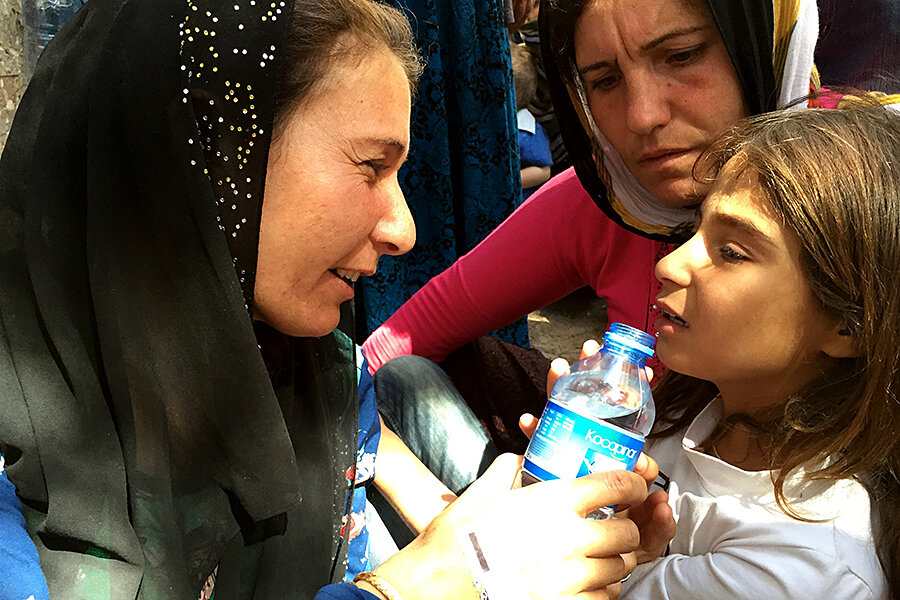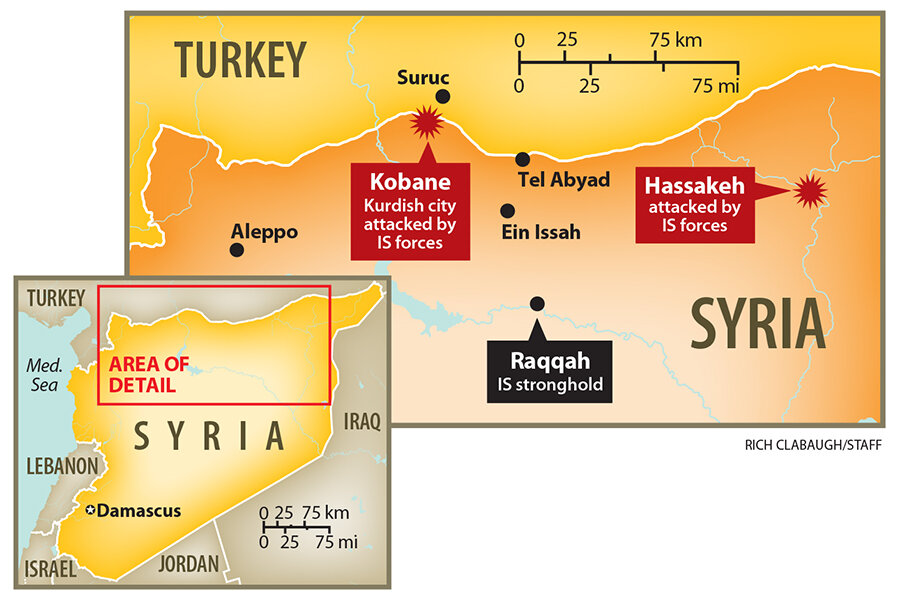Kobane again a source of anguish for Kurds as Islamic State strikes back
| Suruc, Turkey
Islamic State forces launched a stinging, surprise attack on the Syrian border town of Kobane Thursday, slaughtering scores of families in their homes, according to the testimony of survivors and kinsmen.
The anguished mood here in Suruc among Syrian and Turkish Kurds watching the violence unfold over the border echoes similar circumstances last fall in the early days of a months-long siege by IS. The battle for Kobane became a symbol of Kurdish defiance in the face of IS battlefield gains.
The Kobane offensive on Thursday – and an IS attack on another city in northeast Syria just hours earlier – represent an unexpected reversal of fortunes for Kurdish-led forces. They had been celebrating the recent capture from IS of Tel Abyad, a strategic border town that jihadists used to funnel foreign fighters and supplies toward the capital of their “caliphate” in Raqqa.
Sitting in the shade of a tree outside a hospital, a group of women wail and hold tight to six traumatized children. The eldest, seven-year-old Silva Sheikh, is limp with fear, her white T-Shirt stained with blood. She is not sure if it belongs to her mother, father, grandfather or grandmother – all gunned down in front of her.
“I took my brothers and sisters by the hand and we escaped, but I forgot the pram with baby Linda inside,” she cries, unleashing a new wave of sobs around her. The other children, all born one year apart, sit in bewildered silence.
“My neighbors told me IS entered the house and killed everyone but the children” explains their aunt, Aida Sheikh, who collected them after an ambulance brought them across the border. “Everyone we’ve called in Kobane is too scared to go rescue the baby. Look at these innocent children. How will I care for them? What will I tell them?”
Similar circles of mourning dotted the parking lot of the state hospital in Suruc, where ambulances streamed in with multiple casualties, including wounded men and women of all ages. The faces of the dead were concealed with wool blankets. “So far we have received five dead and 138 wounded here,” says an official at Suruc hospital, one of two here taking in casualties.
Pre-dawn suicide attack near border
Kurdish activists inside Kobane gave death tolls upwards of 100, citing massacres inside the town and in surrounding villages. Those waiting at the hospital also expect the numbers to grow; they name lost loved ones by the dozen, relaying reports from those trapped in Kobane.
“My mother, father, brother, sister in law, and niece were killed,” says Emina Ahmed. “They were beheaded by IS militants who came dressed in the uniforms of the (Kurdish) YPG.”
Five months ago, backed by US-led air strikes, Kurdish forces known as the People’s Protection Units, or YPG, broke the brutal IS siege on Kobane. It was the first in a series of triumphs that culminated last week with the takeover of Tel Abyad, a victory that allowed Kurds to connect two of their cantons in northern Syria.
Thursday’s IS offensive opened with a pre-dawn suicide attack near the border gate connecting Kobane to Suruc. It followed an overnight attack on Hassakeh, a provincial capital in northeast Syria, where control is split between Kurdish factions and troops loyal to the Damascus regime.
“These attacks come as a huge surprise to us,” says Fidan Bozan, a Syrian Kurdish nurse who is living in Suruc because her home in Kobane was destroyed in previous fighting. “The war was supposed to be finished, we were all celebrating.”
Allegations IS attacked from Turkey
As was the case when a similar attack rocked the border gate last November, many Kurds were quick to suspect foul play by Turkey, claiming that IS had launched the attack from there.
“It doesn’t make sense for IS to suddenly have so many members in a town surrounded by Kurds,” says Syrian volunteer Shams Shahin, anxiously awaiting news from her sister as plumes of smoke rose over her neighborhood in Kobane.
In the afternoon, the roar of gunfire occasionally interrupted the thumps of shells on Kobane. The official website of the YPG, which Turkey considers to be a branch of a designated terrorist group, the PKK, said about 30 IS militants were killed during the new fighting in Kobane.
“When our YPG friends took Tel Abyad, IS crossed into Turkey. There were less defensive forces positioned in Kobane,” says volunteer Jamal Abelqader, another Kobane native and one of dozens of men and women perched on a hill to watch the clashes unfold below.
Some of the onlookers said the IS attackers carried out a two-prong attack, hitting the center of Kobane. Others speculated the IS infiltrated the town hiding among Syrian Arab refugees.
“We have no clue from where they came from,” admits Mohamed Kuba, an onlooker. “We weren’t expecting this.”







